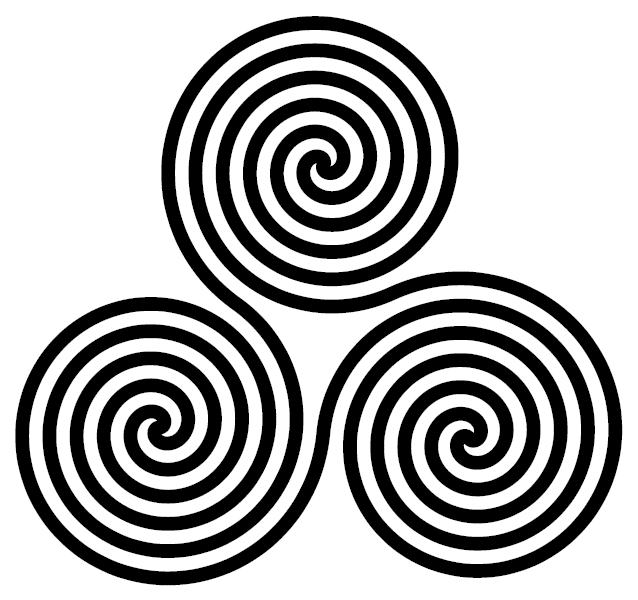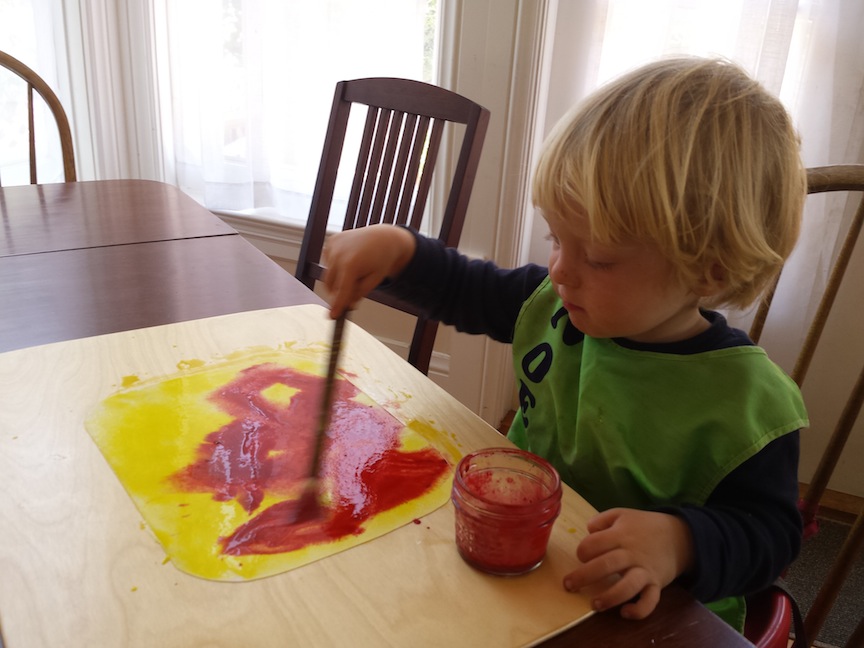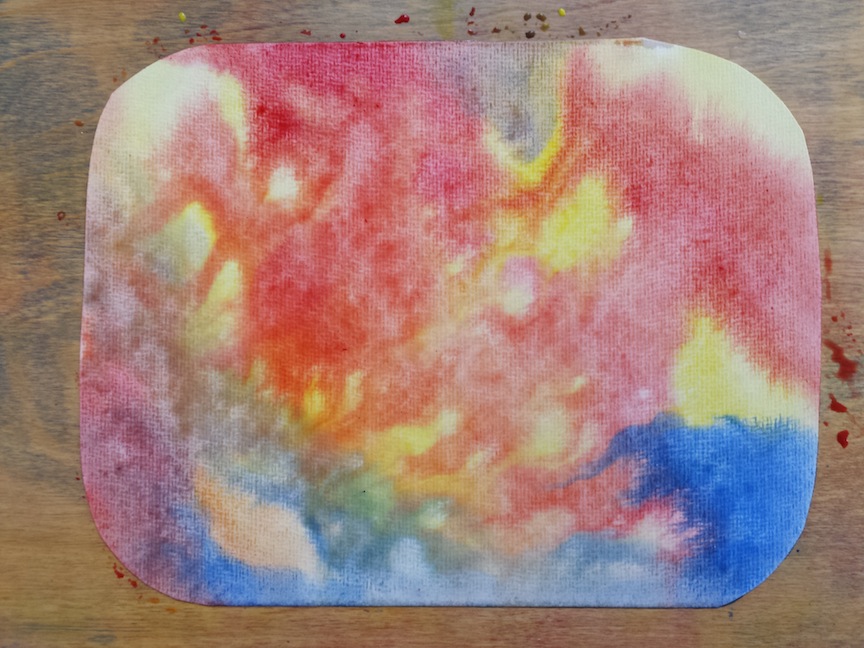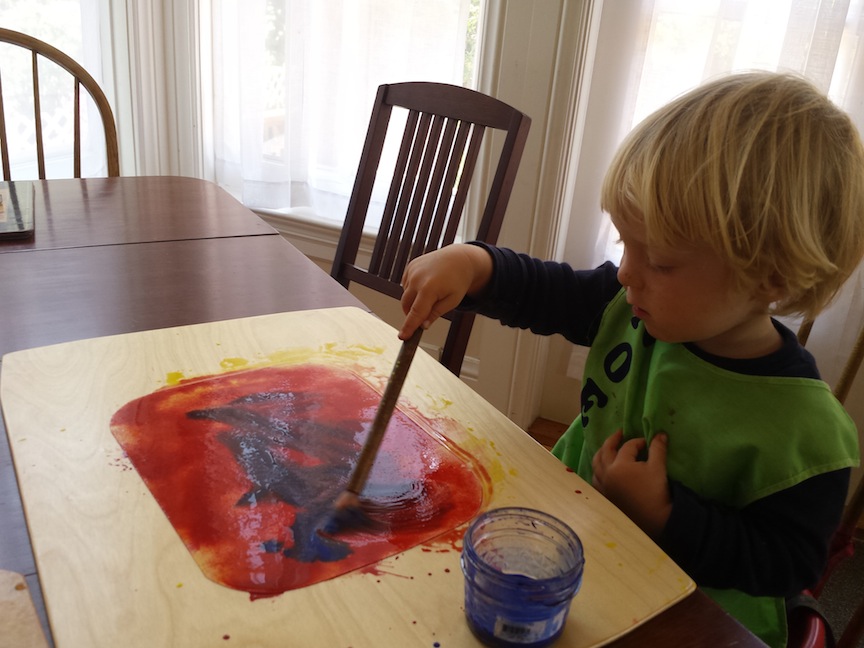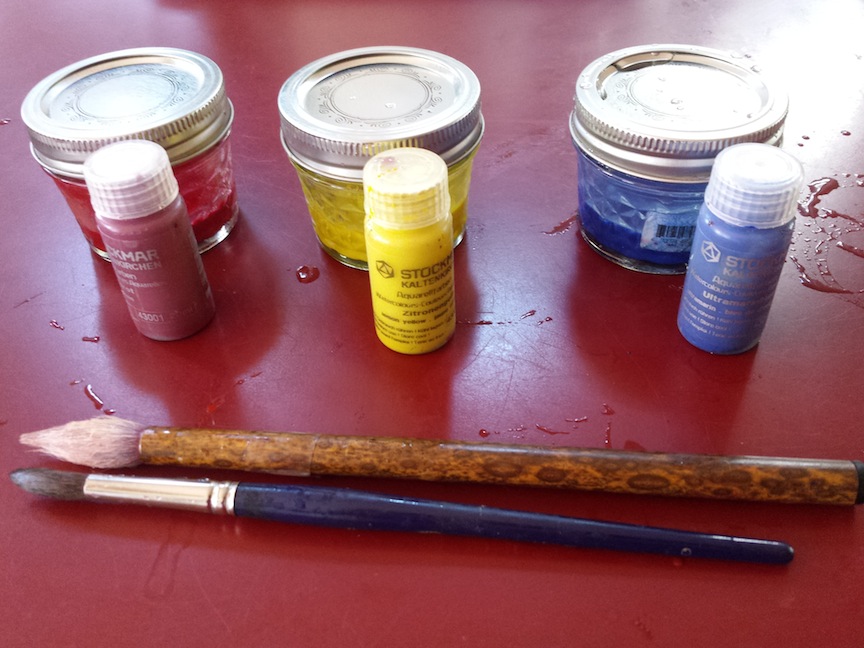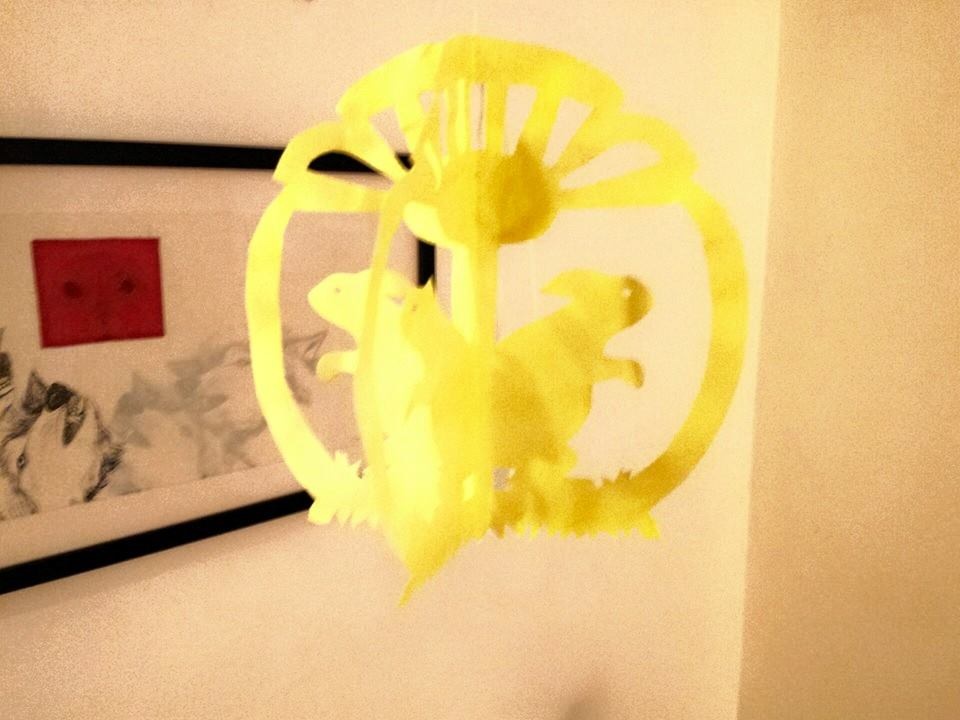Last Tuesday morning, none of us were feeling our best. A dental checkup on a resistant toddler had taken its toll on both of us. I don’t know who was more in need of some art therapy– Ember or me! We recuperated with a peaceful afternoon at home. What better time for wet on wet water color painting? This was one of my favorite traditions from the Waldorf kindergarten.
I remember the ritual well from my days teaching at Brooklyn Waldorf. We would dim the lights, setting out a painting board for each child, and for each, three ramekins of paint– red, yellow and blue. We sang softly as we distributed the brushes. “Rainbow, rainbow. All across the sky you flow. Dive into my colored bowl. Give me up your colors oh.”
The children worked in an atmosphere of meditative silence, brought on by the dim lighting and quiet singing, sweeping bright, paint-wet brushes over the white paper. Colors mixed and made new colors. Glorious abstractions revealed themselves, like tiny galaxies, self-creating, and in motion. Because the painting is wet, it never stops changing until it is dry.
I loved looking at the paintings afterwards, to see how even in abstraction, each painting expressed the personality of its creator. Some had exercised enough restraint to leave a few patches of brilliant red or yellow. While others applied the colors with such gusto that rich brown was the inevitable result. All were beautiful. But it wasn’t about the product. In Waldorf early childhood, the process is everything. Unlike in some other early childhood methods, we didn’t display the paintings or talk about them later. The goal is unselfconsciousness and freedom, immersion in a state of flow.
Now that I’m a mother, I love to do wet and wet painting at home with Ember. We’ve been doing it for some months now. We started with just one color at a time. This gives us the chance to really experience each one. Yellow– exuberant, joyful, enervating. Red– warm, womblike, fiery. Blue– inward, peaceful, melancholy.
Later, we built up to using two colors, and today, for the first time, all three! Usually we just paint quietly while I sing, although sometimes I tell a “color story” as we work.
Materials for Wet on Wet Watercolor Painting
- Aprons or old tee shirts to keep paint off clothes
- Good quality watercolor paper.
- Painting boards. The painting stays on the board as you paint it, and also while it dries. If you purchase painting boards, make sure they are finished to prevent warping. Or finish them yourself, as I did mine, with some form of more eco friendly varnish.
- Liquid watercolor paints in red, yellow and blue. Many Waldorf schools use the brand Stockmar, but I know there are others that work just as well.
- Small jars or ramekins to mix each color in
- Water jar to clean your brush between colors.
- Watercolor brushes for you and your child.
- Optional: Small sponge or rag to dry your brush on after each rinsing.
Instructions
1. Cut watercolor paper to desired size, and soak in water for about 10 minutes. I like to round the corners of the paper, as we did in the kindergarten.
2. Create a peaceful mood. I turn off any bright lights and sing a gentle painting song. You might also light a candle, or put some lavender oil in an aromatherapy diffuser. Think about what you would like to have around you if you were getting a massage in a great spa. Painting day should feel like that.
3. Mix the paint. I use a teaspoon or so of pigment to 1/4 cup water. Even with washing brushes between colors, the colors may get a bit muddy. So for frugality’s sake, it’s good to take out only as much paint as you’re likely to use. 1 tsp pigment dissolved in 1/4 cup is plenty for a painting session.
4. Lay the papers on the painting boards. Holding paper by the sides, lower it gently and slowly to avoid creating air bubbles between the paper and the board. Set out brush and one color of paint.
5. Sit down with your child and enjoy painting together! Resist the urge to talk or comment on what your child is doing. The best thing is to just experience the color together. If you’re working with multiple children, and it gets chatty, you might say, “Let’s see if we can quiet our voices, so that we can hear what the colors want to say to us.”
After you’ve worked with one color individually for a while, you might feel that it’s time to introduce a second. Sharifa Oppenheimer, in her book Heaven on Earth, has some wonderful suggestions for how to introduce the colors in a way that follows the seasons. She also describes how to create a “color story” to tell when painting.
6. After each color, wash your brushes well. Swish them in your water jar. Then squeeze them out until the water runs clear, or nearly so. Blotting them on a small sponge or rag is also helpful.
7. When your child is finished, again resist the urge to comment on what they’ve done. If it feels like you need to say something, focus on the experience you’ve had. “How lovely it was to hear our colors speaking today!” It is such a gift for a busy mama and child to have quiet, peaceful moments together. Let this activity be one of those moments of peace and calm, and you will both feel renewed by it.
8. If you’re like me and don’t like to waste things, there are lots of uses for finished paintings. Greeting cards, envelopes, wrapping paper, mobiles, bookmarks, lanterns, paper Easter baskets, valentines, paper dolls, seasonal decorations and garlands… I have seen wet on wet paintings used for so many things!
The paper is thick enough that it behaves a little more like cardboard than like paper. Just note that since this is watercolor, it can rub off, so be careful if it’s going to be touching something you care about.
Finally, here’s one more useful resource– Sarah Baldwin is a former Waldorf early kindergarten educator who now runs Bella Luna Toys. She has a YouTube video where she demonstrates this technique.
Thanks for reading, all. And happy painting!
Noe and Ember
